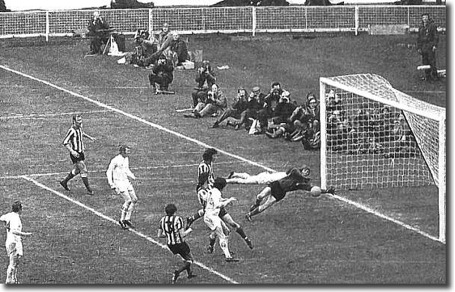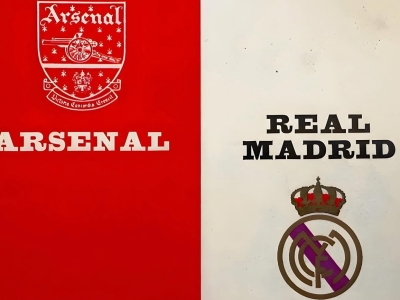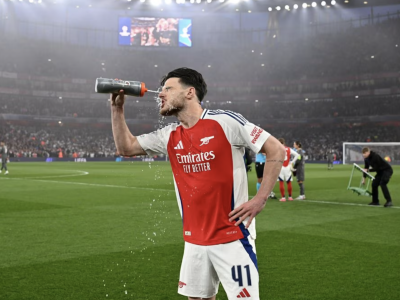Rather like Arsenal, Sunderland too were formed by a Scotsman called James Allan in 1879, who worked as a schoolmaster. The club was originally known as Sunderland & District Teachers Association Football Club to provide recreational amusement for fellow teachers in the Sunderland area. By 1881 non-teachers were admitted, meaning that the club’s name had been abbreviated to Sunderland Association Football Club and turned professional in 1885. The side defeated Middlesbrough in the FA Cup in December 1887, however were disqualified for fielding three ineligible players who were imported from Scotland specifically for the tie.
It was partly this instance, as well as the general commercial direction which the club took, which led to the departure of James Allan along with seven other fellow players disgruntled by professionalism to form local rival side Sunderland Albion. Such was the animosity between Sunderland AFC and Sunderland Albion that when the two sides were drawn together in the FA Cup and the Durham Challenge Cup, the former withdrew from both competitions in order to deny the latter increased gate receipts. After Allan left Sunderland AFC, into the void stepped Tom Watson who played a prominent role in Newcastle East End and Newcastle West End – both of whom were ancestor sides of Newcastle United – who joined them in 1889.
That year too there was an indication of Sunderland’s promise as they defeated Preston North End’s invincibles in a friendly fixture played in April 1889. They attracted the attention of the founder of the Football League - William McGregor – who enthused that the club had ‘a talented man in every position’. Sunderland applied to join the Football League, which at the time revolved around sides in the North and Midlands. An offer by Sunderland to pay towards other clubs' travelling costs to compensate for the extra distance member clubs would need to travel up to the North East helped to tip the balance in their favour. Sunderland became League Champions in only their second League season, finishing five points clear of the dominant Preston North End side under a two points for a win system, as well as retaining the title a year later becoming the first side to score one hundred league goals, carried out in just a thirty game season.
That season, Woolwich Arsenal played their first fixture against Sunderland away in the FA Cup First Round in January 1893, where Sunderland inflicted a 0-6 defeat on the Gunners. In 1893/94 Sunderland missed out on a hat-trick of titles, coming second to Aston Villa, though won back the title in 1894/95 finishing five points clear of Everton in second place. That same season Sunderland won the Football World Championship, which was a fixture between the winners of the England and Scottish Leagues, by beating Heart of Midlothian 5-3. Rather than American-style arrogance, the name was based on the fact the English and Scottish Leagues were the only ones that existed anywhere in the world at the time. Sunderland’s initial dominant phase however ended when Tom Watson was poached by Liverpool.
Sunderland added a fourth league title in 1901/02, however the dominance of sides such as Sunderland, Aston Villa and Preston North End, who by this point had together won eleven out of fourteen contested League Champions, meant that the Football League had implemented a maximum wage and retain and transfer system to ensure competitive balance, measures which remained unchallenged until the 1960s. After this, Sunderland would only win two further League titles. In 1904 Sunderland hired Bob Kyle as Secretary-Manager, who stayed in the role for twenty three years and remains the only Irishman to manage an English League Championship side. Woolwich Arsenal’s first League fixture against Sunderland came in November 1904 in front of 30,000 spectators at Plumstead’s Manor Ground, which ended in a 0-0 draw.
In 1911, Sunderland signed former Arsenal youth Charles Buchan from Southern League side Leyton F.C. (not the Orient) for a record of £1200. Buchan originally wasn’t very popular with the Sunderland fans, however went on to become the club’s top scorer for seven of the next eight seasons either side of the First World War, as well as aiding them to the League title in 1912/13 however Sunderland missed out on the double after losing that year’s FA Cup Final to league runners up Aston Villa at Crystal Palace (the penultimate FA Cup final to be played at the venue). Sunderland also finished as runners up in 1922/23, six points behind Champions Liverpool.
In 1923/24 Sunderland were involved in the title race and two points clear at the top of the table when Buchan was called up to play for England ahead of a Sunderland visit to Highbury to face Arsenal which resulted in a 2-0 win for the Gunners. A week later the two sides met at Roker Park, with Sunderland only managing a 1-1 draw. The latter fixture took place on Easter Saturday, with Sunderland playing three fixtures over the four day weekend, also losing away at West Brom on Easter Monday, which significantly hit Sunderland’s title chances. That season they finished four points behind Champions Huddersfield in third place. In the summer of 1925, at the age of thirty four Herbert Chapman called into Charles Buchan’s sports shop in Sunderland personally to sign him for Arsenal.
Sunderland’s replacement would also be a future Arsenal player, David Halliday, who went on to score an incredible 156 goals in just 166 games for Sunderland. In his final season at Sunderland he broke the club’s record for the most goals in a season – forty three – before transferring to Highbury. Halliday however only played for Arsenal for the 1929/30 season, scoring eight goals in fifteen games, though four of which came in his final game – a 6-6 draw away at Leicester, a week before the 1930 FA Cup Final, which Arsenal went on to win. Their first game after that triumph had been against Sunderland at Highbury, whose players gave Arsenal a guard of honour. Sunderland however went on to inflict a 0-1 defeat on Arsenal that day. The Gunners however came to dominate English league football over the following season, with a 6-1 defeat of Sunderland at Highbury in September 1932, with a hat-trick from Joe Hulme and goals from David Jack, Ernest Coleman and Cliff Bastin.
By 1934/35 however Sunderland began to re-build a decent side, featured here in Pathe’s series on top English sides in training, and began to challenge Arsenal in the title race - even inflicting a 1-2 defeat on Arsenal at Roker Park in October. At the time of Sunderland’s visit to Highbury the following March the Rokerites were two points off Arsenal in the title race. The fixture brought a record 73,295 crowd for a fixture at Highbury (a record which lasted until Arsenal played Lens at Wembley in 1999, where an extra 412 people turned up at the National stadium to see an Arsenal Champions League group fixture). The match ended in a in 0-0 draw which must have been a disappointment to the huge crowd that attended, but obviously aided Arsenal’s title push and a third successive title which followed in May.
A more entertaining contest followed at the start of the 1935/36 season when Sunderland next visited Highbury, as Arsenal ran out 3-1 winners. The title however headed away from Highbury as Sunderland became 1935/36 league champions, the last time that the title would head to Wearside. Sunderland finished the season eight points ahead of runners up Derby County and eleven ahead of Arsenal in sixth place. Arsenal’s visit to Roker Park that season brought a nine goal thriller as Sunderland inflicted a 4-5 defeat on Arsenal, with goals from Ray Bowden, Cliff Bastin and Ted Drake and an own goal. Sunderland’s trophy winning run continued into the following season by winning the 1937 FA Cup Final, after going a goal down. This was the first time in which Sunderland had won the trophy and among the goal scorers that day had been Sunderland’s captain Raich Carter, who went on to 118 goals in 245 games throughout the 1930s.
The 1937 FA Cup win however would be Sunderland’s last trophy for over three and a half decades. After the war, Sunderland would visit Highbury on the opening day of Arsenal’s first post-war title season. Arsenal won 3-1 with goals from Jimmy Logie, Ian McPherson and Ronnie Rooke. In 1948/49, Sunderland would be on the receiving end of a major FA Cup upset losing 1-2 to non-league Yeovil who at the time were managed by Alec Stock, who was a future Arsenal assistant manager and actually cited as the inspiration for The Fast Show’s Ron Manager by his creator, Paul Whitehouse. However, as this Pathe News footage of the match shows, much of the footage of this game was lost due to a thick fog which descended in the Second Half.
During the late 1940s and early 1950s, Sunderland became known as the ‘Bank of England’ club for their free spending manner. In 1948 Sunderland signed Len Shackleton from their neighbours, Newcastle United, who were then languishing in the second tier. Shackleton started his career at Arsenal as an amateur while working on the ground staff. Shackleton once stated: ‘any 15-year-old boy, invited to join the greatest club in the world, would have been out of his mind to think twice’. Shackleton played just two reserve games, however wasn’t offered a professional contract. George Allison had told Shackleton: ‘Go back to Bradford and get a job. You will never make the grade as a professional footballer’. Shackleton did so and played for the now defunct Bradford Park Avenue.
After the war Shackleton signed for Newcastle United, scoring six goals on his debut against Newport County in a 13-0 victory for the Geordies. Shackleton remarked of the day that Newport were so poor that they were: ‘lucky to get nil’. After leaving Newcastle for local rivals Sunderland, Shackleton once said his old club: ‘I'm not biased when it comes to Newcastle – I don't care who beats them!’ something which even Sol Campbell never went as far as saying about Tottenham! In August 1952, Shackleton got his revenge on Arsenal for discarding him as a youth by inflicting a 1-2 defeat on the Gunners with Sunderland. With five minutes to go and winding down the clock, Shackleton dribbled the ball into Arsenal's penalty area before putting his foot on it, pretending to comb his hair while looking at his watch.
Sunderland’s spending at the time included paying a world record fee of £30,000 to Aston Villa for Trevor Ford, who scored a hat-trick as Sunderland thrashed champions Arsenal 1-7 at Roker Park in 1953/54. That season Sunderland signed nine players for a total of £70,000, which included Ray Daniel from Arsenal. At Highbury the following January, Sunderland inflicted a 1-4 defeat on Arsenal, however despite splashing the cash the Rokerites finished the season narrowly avoiding relegation in eighteenth position. The nearest in which free spending Sunderland came to winning a trophy was reaching the FA Cup Semi Final in 1956, however they lost 0-1 to Birmingham City at Hillsborough.
The ability to buy success in the 1950s however was greatly restricted by the existence of the maximum wage. However in 1957, after Trevor Ford had left the club to join Cardiff, he had admitted in his autobiography to having received under the counter payments from Sunderland. An FA investigation had confirmed that Sunderland had made illegal payments to players in order to get around the maximum wage rule. Evidence was uncovered of a string of payments, totalling just over £5,000 (£108,000 in today’s money), to contract companies who were purposely charging Sunderland excessive fees for services and later sending credit-notes to redress the balance, which in turn were passed on to players.
Six Sunderland players were charged by the Football League with accepting illicit payments - including record signing Trevor Ford and Ray Daniel – and threatened with expulsion from the game. PFA chairman Jimmy Hill however, as part of a growing campaign to abolish the maximum wage, collected signatures from over 250 players across the country admitting to the very same offence and presented it to the Football League. Fines and suspensions were handed out to the guilty players, while Sunderland’s manager, chairman and trainer would all resign amid the scandal. Worse was to follow for the Rokerites as Sunderland slipped out of the top tier at the end of the following season for the first time in their history, after finishing in twenty first position, having been a fixture in the top tier since 1890.
Sunderland remained in the second tier for six seasons, during that time however Arsenal visited Roker Park in the third round of the FA Cup in 1961 and suffered a 1-2 defeat. One star who turned out for the Wearsiders during this period was Brian Clough, who scored sixty three goals in seventy four games for Sunderland. However, on Boxing Day of 1962 Clough suffered an injury at Roker Park against Bury which caused his early retirement and consequently led to his early entry into Football management. Sunderland achieved promotion as runners up to second tier champions Leeds United in 1963/64. On their return to the top tier Sunderland faced Chelsea for their first appearance on Match of the Day, however lost 1-3.
Unlike Leeds Utd, Sunderland’s return to the top flight saw them finish in the bottom half of the table for six season in a row. Arsenal won six out of their first seven fixtures against Sunderland on their return, with the only win for Sunderland during the 1960s coming in 1967/68 with Arsenal suffering a 0-2 defeat at Roker Park. That same season, a 2-1 win for Sunderland at Old Trafford costed Man Utd the title. Sunderland suffered relegation back to the second tier again at the end of 1969/70. That season Arsenal beat Sunderland 3-1 at Highbury with goals for Ray Kennedy, Peter Storey and Eddie Kelly. It would however be Arsenal’s last victory over Sunderland in all competitions for the next fourteen years.
Again, there would be no quick return to the top flight for Sunderland. However one of the last great moments in the club’s history occurred during Sunderland’s six year absence from the top tier in the FA Cup, which was made all the more unforeseeable by the fact that Sunderland had only won one match in the FA Cup in the five campaigns before 1972-73. In November 1972, Bob Stokoe took over a Sunderland side fourth from bottom of the second tier. In the FA Cup, Sunderland had made it past Notts County and Reading in the third and fourth rounds before meeting title challengers from the season prior, Manchester City. Sunderland held City to a 2-2 draw at Maine Road, before a 3-1 triumph back at Roker Park.
In the Quarter Finals the Wearsiders saw off Luton Town at Roker Park with a 2-0 win, before being drawn against Arsenal in the Semi Finals at Hillsborough. Arsenal were looking to become the first side during the twentieth century to reach three successive FA Cup Finals and, as Peter Storey stated in his autobiography: ‘nobody outside Wearside could have expected us to lose to Sunderland in the semi-final at Hillsborough. They were nothing more than a middle-to-average sort of Second Division side’. Sunderland opened the scoring as Vic Halom pounced on a weak back pass from Jeff Blockley. Billy Hughes put Sunderland two ahead with a header which looped over Bob Wilson.








